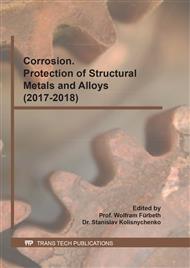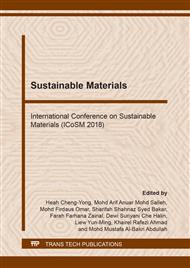p.200
p.206
p.215
p.221
p.226
p.231
p.237
p.243
p.251
The Effect of Current Densities in Zinc Electroplating Process on Mild Steel for Soil Water Environment Application
Abstract:
For more environmental friendly study, commonly undesired natural process which is corrosion will present. Thus, in this century there is a serious effort in ongoing analysis in order to prevent this phenomenon occurring. The challenge of corrosion in manufacturing and domestic sector is enormous. Thus, corrosion can be defined as the deterioration and destruction of a material because of reaction with the environment. Replacing a corroded pipeline can cost about $643,000 per kilometer. The application of the traffic sign or a road sign that embedded in soil usually can withstand for two to three years until it will corrode and then fracture. The main objectives of this study is to increase the protection on the surface of the materials towards corrosion and to improve the appearance of the product or serves as an effective undercoat for paints which can reduce the cost of using expensive material by using the other method; electroplating process. The samples were plated with zinc at 2, 4 and 6 A/dm2 for 20 minutes for every sample. Then, the samples were immersed in the artificial soil solution for 30 days, then the testing to measure the corrosion rate, phase analysis, morphological analysis and hardness test were conducted. From all the tests, sample with 6 A/dm2 got the best results with 5.2059 mpy and 80.6 HV hardness strength. It is because by increasing the current density, the thickness will then increase the zinc plating will not easily peel off and attack by corrosive agent.
Info:
Periodical:
Pages:
226-230
Citation:
Online since:
August 2018
Authors:
Keywords:
Price:
Сopyright:
© 2018 Trans Tech Publications Ltd. All Rights Reserved
Share:
Citation:



